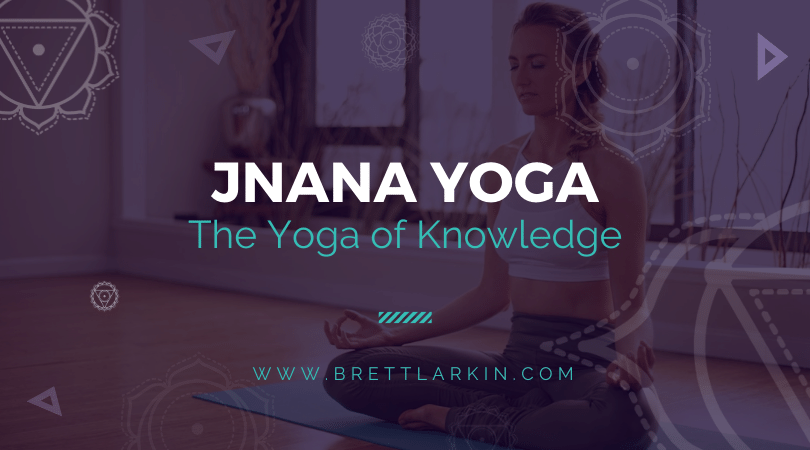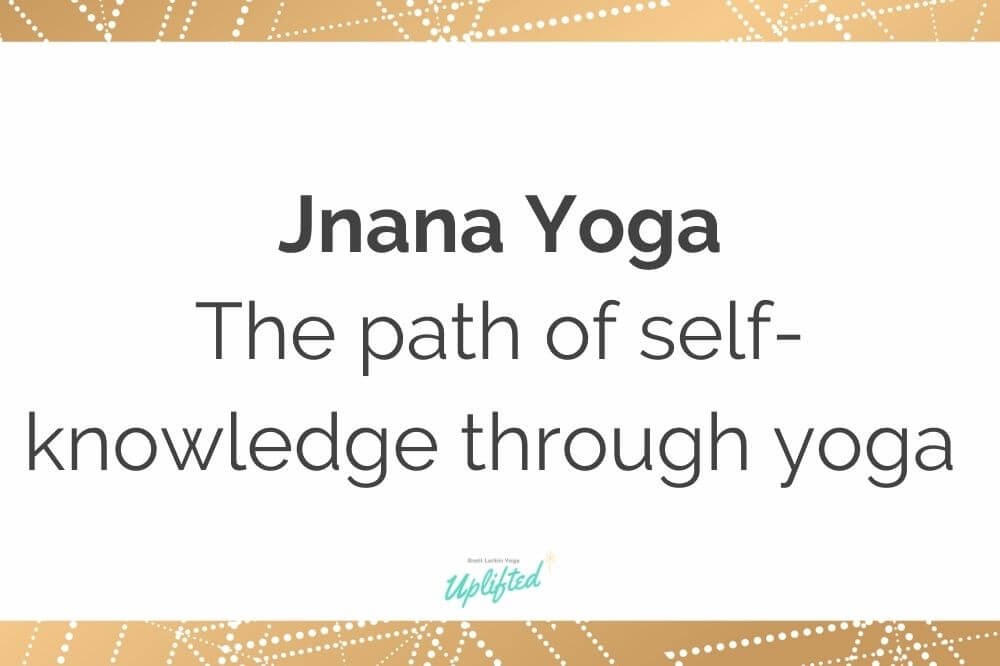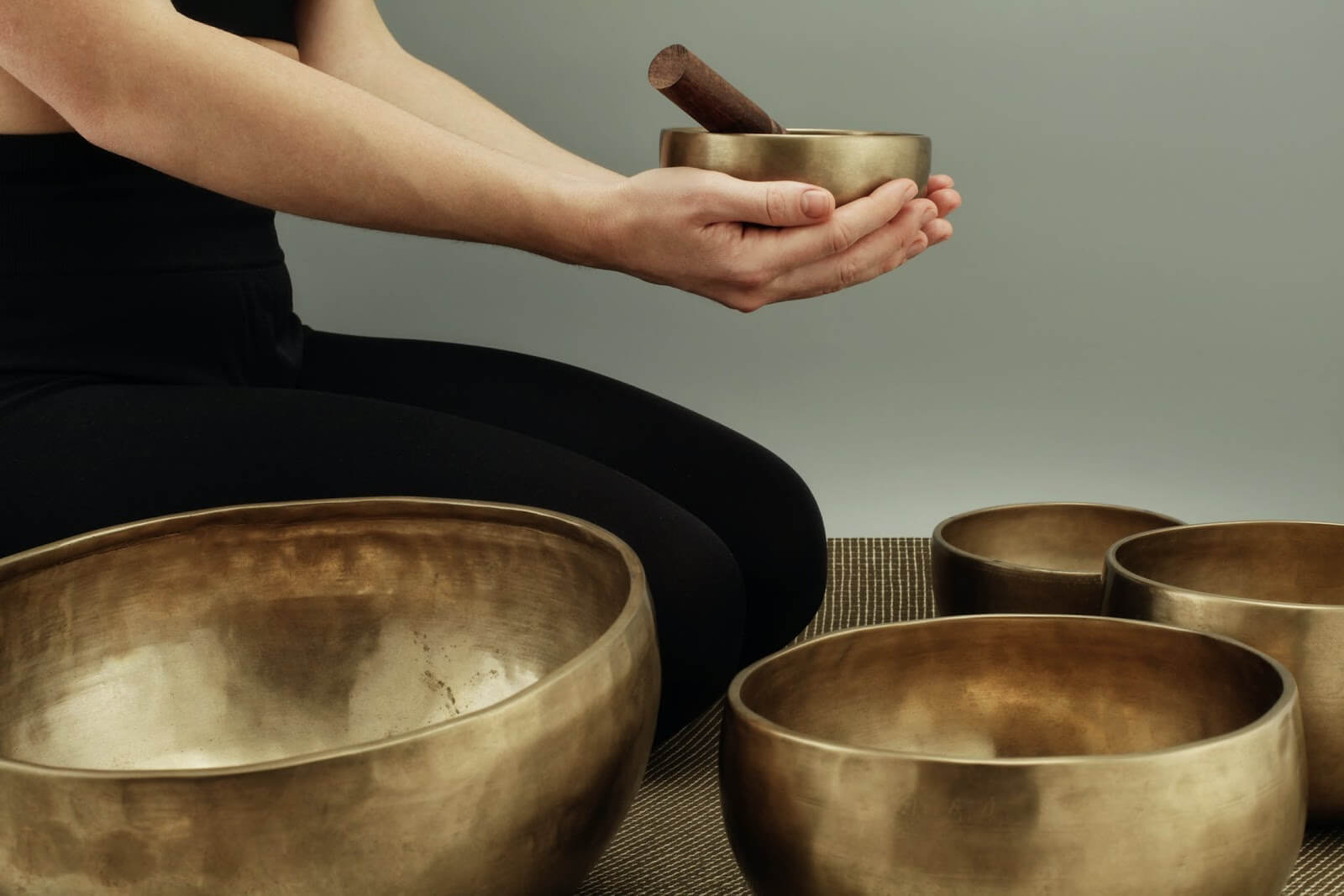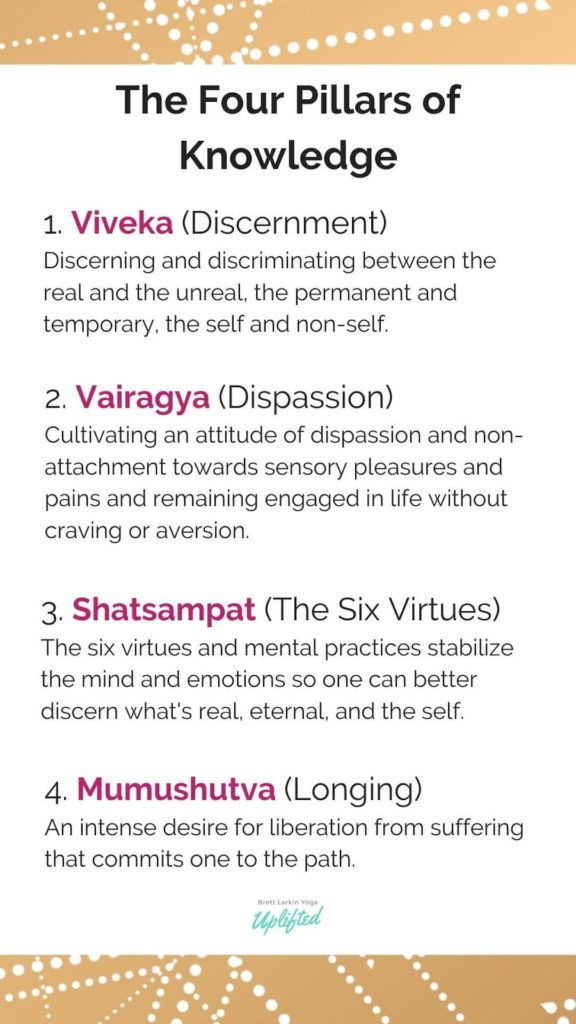
You probably know by now that yoga is more than just the yoga poses of hatha yoga.
Wonderfully, there are many paths of yoga and different ways you can achieve spiritual liberation—if you’re into that sort of thing. 😉
Having many options for anything usually leads to the question: Which type is best for me?
Like with exercise, the best path of yoga for you…is the one that you will do!
You might start with the one you are naturally drawn to and then it’s normal to switch or add on with time.
In fact, Swami Sivananda, Sri Aurobindo, Sadghuru, and Ashtanga yoga teacher Gregor Maehle are a few of the renowned teachers who say there is benefit to performing practices from all the main paths of yoga because we are multidimensional beings (plus many paths overlap with each other!)
So to help you discover the best type(s) of yoga for your unique journey, let’s take a little tour of another fascinating yogic path, the path of knowledge, jnana yoga. We’ll look at what it is, the traditional practices and stages, and how to practice it today.
What is Jnana Yoga?
Jnana yoga, also called gyana yoga or jnana marga (marga means “path”), is one of the traditional yoga systems.
The three traditional yoga systems based on the main parts of the Vedas (more on those below) and outlined in the famous Hindu text the Bhagavad Gita are:
- Bhakti yoga – The yoga of devotion
- Karma yoga – The yoga of action
- Jnana yoga – The yoga of knowledge
So while the tool for achieving yoga in bhakti yoga is the heart or emotions and the tool of karma yoga is the body, the tool of jnana yoga is the mind.
As Ram Dass says, jnana yoga is “using the mind to beat the mind” as it’s using the mind to examine its own nature.
Jnana yoga is considered the path of knowledge, which has led to its association with studying scriptures. While this is part of this path, the knowledge sought in jnana yoga is the knowledge of the self via direct experience of the supreme self in the state of yoga or union with the divine.
Jnana yoga involves study of the scriptures, meditation, and self study via the contemplation of questions such as “Who am I?” to transcend the ego-mind and achieve direct realization (a direct encounter with the truth of reality as opposed to belief).

Jnana Yoga Philosophy
Let’s take a bit of a deeper dive into Hindu philosophy to help us better understand the jnana yoga approach to direct realization. (Note that the confusion that yoga is part of Hinduism comes from their shared philosophical foundations.)
Jnana yoga is associated with Advaita Vedanta, one of the traditions of Vedanta philosophy (veda means “knowledge” and anta means “end”).
Vedanta philosophy arose from the oldest Hindu scriptures, the Vedas, and relates to themes such as existence, the nature of reality, liberation, and the relationship of Brahman (ultimate reality) and Atman (individual soul or self)—you know, just some light subject matter!
The different paths of yoga have different views on the relationship between the individual and the divine which influences the view, practices, and what the state of yoga means for each path.
Generally, yogic traditions are rooted in one of two views on the relationship between the individual and god or source:
- Dual – The universal soul and the individual soul are separate or “two”
- Non-dual – The universal soul and the individual soul are NOT separate or “not two”
Jnana yoga’s association with Advaita Vedanta means that it’s based in non-duality (in Sanskrit Advaita means “not two”).
In Advaita Vedanta, Brahman is considered the one and only reality and everything is a projection of this reality. In a sense, Brahman is similar to the concept of god, but in this tradition it’s described as the absolute truth and sole unchanging reality that is both the source of all existence and one with all existence. Brahman is believed to be the soul of each being and the universe itself and thus Brahman and Atman are one.
The “problem” of the human being is their ignorance (avidya) of this fact, which creates separation and suffering. The spiritual practice of jnana yoga seeks to remove this ignorance by leading the yogi to direct experience of their oneness with Brahman.
What Does Jnana Yoga Mean?
The most common translation of the word jnana is “to know”, which here means not just intellectual knowledge but spiritual knowledge, and specifically it means to know oneself as Brahman.
It’s helpful here to consider two types of “knowing”:
- Intellectual understanding – “to know ABOUT”
- Direct experience – “to know FIRST-HAND”
For example, the first type might be studying about India and learning facts about it while the second type would be going there and experiencing it first-hand.
While the jnana yogi engages the mind in the first type of knowing through studying and discussing the scriptures with teachers, simply intellectualizing about philosophy can be a barrier that traps them even more in the ego-mind and further from self-realization and spiritual liberation.

Because it’s said that Brahman can’t be perceived by the intellect, intellectual understanding must be put into practice in order to reach the second type of knowing that is the aim of jnana yoga: the direct experience of Brahman as oneself.
Since the aim of all yogic paths is the experience of union with the divine, in a sense the aim of all yoga is actually jnana yoga—the first-hand knowledge of oneself as one with the source.
As such, it’s considered the most direct path of yoga, but it’s also considered the most difficult according to some renowned teachers such as Sri Ramakrishna, Swami Sivananda, and even Lord Krishna in the Bhagavad Gita.
Hence why it’s recommended for practitioners to have a foundation in other types of yoga to purify their hearts and sharpen their minds before beginning jnana yoga.
The Traditional Practices & Stages of Jnana
The Four Pillars of Knowledge (Sadhana Chatushtaya)
It is suggested that we work on these pillars sequentially, not progressing to the next until we have a firm grasp (though not necessarily mastery) of the previous one.
1. Viveka (Discernment)
Discerning and discriminating between the real and the unreal, the permanent and temporary, the self and non-self.
2. Vairagya (Dispassion)
Cultivating an attitude of dispassion and non-attachment towards sensory pleasures and pains and remaining engaged in life without craving or aversion.
3. Shatsampat (The Six Virtues)
These six virtues and mental practices stabilize the mind and emotions so one can better discern what’s real, eternal, and the self.
- Shama (tranquility) – Controlling the mind by controlling its reaction to stimuli and desires
- Dama (restraint) – Controlling the senses and using them in service of the mind instead of allowing the mind to be controlled by them
- Uparati (renunciation) – Letting go of all worldly longings other than living one’s dharma and the spiritual path
- Titiksha (endurance) – The ability to endure situations that usually cause suffering
- Shraddha (faith) – Believing in one’s guru, the yogic texts, and the yogic path
- Samadhana (concentration) – Mental focus and one-pointedness
4. Mumushutva (Longing)
An intense desire for liberation from suffering that commits one to the path.
The Three Core Practices Of Jnana Yoga
After one has integrated the four pillars into their life, they are considered ready to begin the core practices of jnana yoga that can lead to direct realization.
1. Sravana (Hearing)
Sravana means to “hear” or experience sacred knowledge via reading and discussing ancient texts and engaging in philosophical discussions with a guru or teacher. Traditionally, jnana yogis might study the Upanishads and the Advaita Vedanta perspective on Atman and Brahman.
2. Manana (Reflection)
To practice manana, the student reflects upon and contemplates what they learned in sravana.
3. Nididhysana (Meditation)
In nididhysana, the yogi meditates on the inner self and non-dual concepts such as the Mahavakyas, the “great sayings” of the Upanishads.
The Seven Stages of Wisdom
As a yogi becomes adept with the four pillars of knowledge and the three core practices of jnana yoga, they may notice a progression through the seven stages of wisdom or the jnana bhumikas.
1. Shubheccha (Good Desire)
In the first stage, the yogi notices a desire to discover the truth that drives them to passionately study the Sanskrit texts and makes them indifferent towards sensory objects.
2. Vicharana (Philosophical Inquiry)
In the second stage, the student questions, contemplates, and reflects on the principles of non-dualism.
3. Tanumanasi (Subtlety of Mind)
Tanu means “thread” and in this stage the mind becomes “thin like a thread” as the yogi is indifferent to external attractions and can focus all awareness inwards.
4. Sattvapatti (Attainment of Light)
In the fourth stage, karma and desires dissolve, life begins to appear like a dream, and the yogi sees all things equally.
5. Asamsakti (Inner Detachment)
As the yogi becomes detached from the ego in the fifth stage, they experience deep bliss and feel no difference between waking and dream states.
6. Padartha Bhavana (Spiritual Vision)
In the sixth stage, the yogi has an understanding of the absolute truth and nature of Brahman.
7. Turiya (Supreme Freedom)
Turiya is considered the fourth state of consciousness that contains the other three states (waking, dreaming, and sleeping) and is called super or pure consciousness. In this state, the yogi experiences their non-dual self as one with all and attains spiritual liberation.
How to Practice Jnana Yoga Today

If you’re feeling inspired to explore the path of self-knowledge, here are a few modern-world ways to start practicing jnana yoga.
Practice Other Types of Yoga
Okay, this one’s not a trick LOL…it’s just counter-intuitive! Recall that jnana yoga is considered the toughest path and so it’s recommended to have a foundation of self-control and working with the body-mind through other types of yoga first! Renowned Vedic teacher David Frawley says, “All the other Yogas help you with Jnana Yoga.” So if you’re new to yoga, start practicing karma, bhakti, or hatha yoga to create a solid foundation for jnana yoga practice.
Sit Still
Not only is sitting in many ways THE yoga pose, but committing to sitting still for a few minutes is a powerful and concrete way to cultivate some of the four pillars of knowledge. Grow viveka to discern the desire to move as fleeting and temporary; practice vairagya to remain unattached to the perceived pleasure or pain that would be attained by moving; develop sama as you practice mental tranquility amidst the urge to move; use dama to turn your senses back inwards away from external stimuli; build titiksha as you endure temporary mild discomfort; and rest in sraddha and the faith that this practice is for the higher good.
Self Inquiry: Who Am I?
If you are familiar with meditation practice, explore using the ego-mind itself as the object of meditation as inspired by Ramana Maharshi’s “Who Am I” meditation. Quiet your mind and then wait for thoughts to arise. As a thought arises inquire, “To whom has this thought arisen?” The resulting answer will be “to me”. Then ask, “Who am I?” This question is said to destroy other thoughts and help us disidentify with the mind and body. Then start the practice again from the beginning over and over as you continue to rest more in pure awareness.
Study the Texts
After you’ve explored the four pillars, try the three core practices of jnana yoga by studying a text that resonates with you. Traditionally, jnana yogis might study the Upanishads or the Brahma Sutras. Find an Upanishad or yoga sutra that resonates with you, contemplate it via research and discussion with a teacher, then meditate on it. You may also consider reading works by some of the many renowned teachers of Advaita Vedanta and jnana yoga such as Adi Shankaracharya (aka Adi Shankara), Gaudapada, Nisargadatta Maharaj, Swami Vivekananda, Swami Sivananda, and Ramana Maharshi.
You might also like: The 8 Limbs of Yoga
Find a Teacher
Since jnana is considered the most difficult path of yoga, if you’re really feeling called to this path, find a teacher that can help you understand the ancient texts, point out your blind spots, and recommend practices for you.
Next Steps
- If you’re interested in practical kriya yoga as a way to improve your daily life and relationships, check out my Yoga for Self Mastery course.
- Order my Yoga Life book for a practical guide to creating balance in your life through yoga.
- Check out my YouTube channel and find some yoga classes that you can try out for yourself!
Experience 3 Training Videos from Inside My 200-Hour Online YTT

YOU MIGHT ALSO LIKE
- What is Kriya Yoga? The Philosophy and Practice
- Uddiyana Bandha: Tapping Into Your Deep Core
- 4 Reasons Hasta Bandha Is Essential To Your Yoga Practice
- Vitarka Mudra: What It Is and How Do You Use It?
- Shakti Mudra: What It Is and How Do You Do It?
- Garuda Mudra: What It Is and How Do You Use It?
- Kali Mudra: What It Is and How Do You Do It?
- Shunya Mudra: What It Is and How Do You Do It?
- Varuna Mudra: What It Is and How Do You Use It?
- Vayu Mudra: What It Is and How Do You Use It?
- Samana Vayu: The Energy of Balance & How to Access It
- Apana Vayu: The Energy of Release & Surrender
- Udana Vayu: The Ascending Wind
- Prana Vayu: The Breath of Vitality
- Vyana Vayu: The Energetic Secret to Flow
Learn how to do 11 of the most popular yoga poses correctly. Free video + PDF download.











